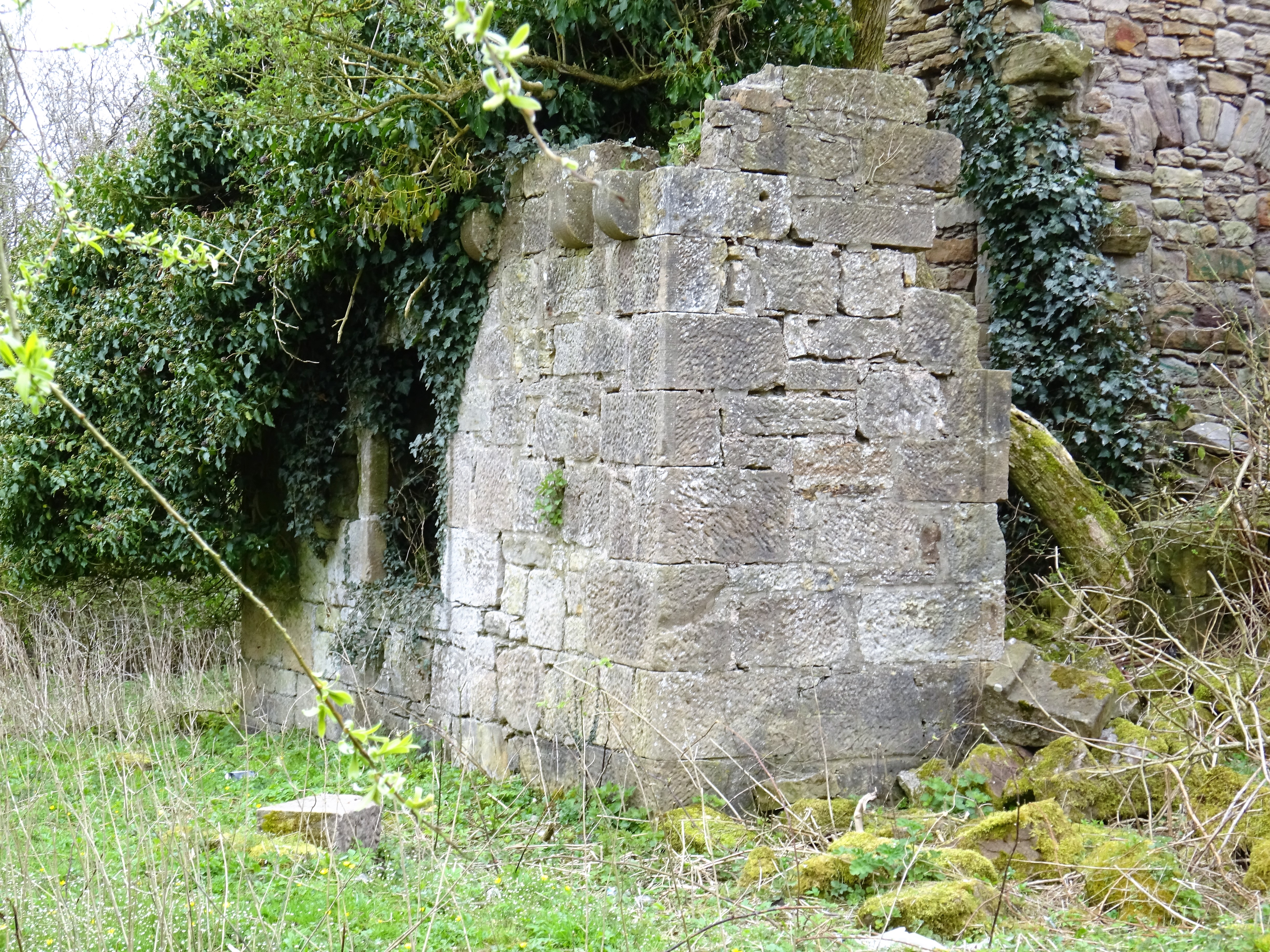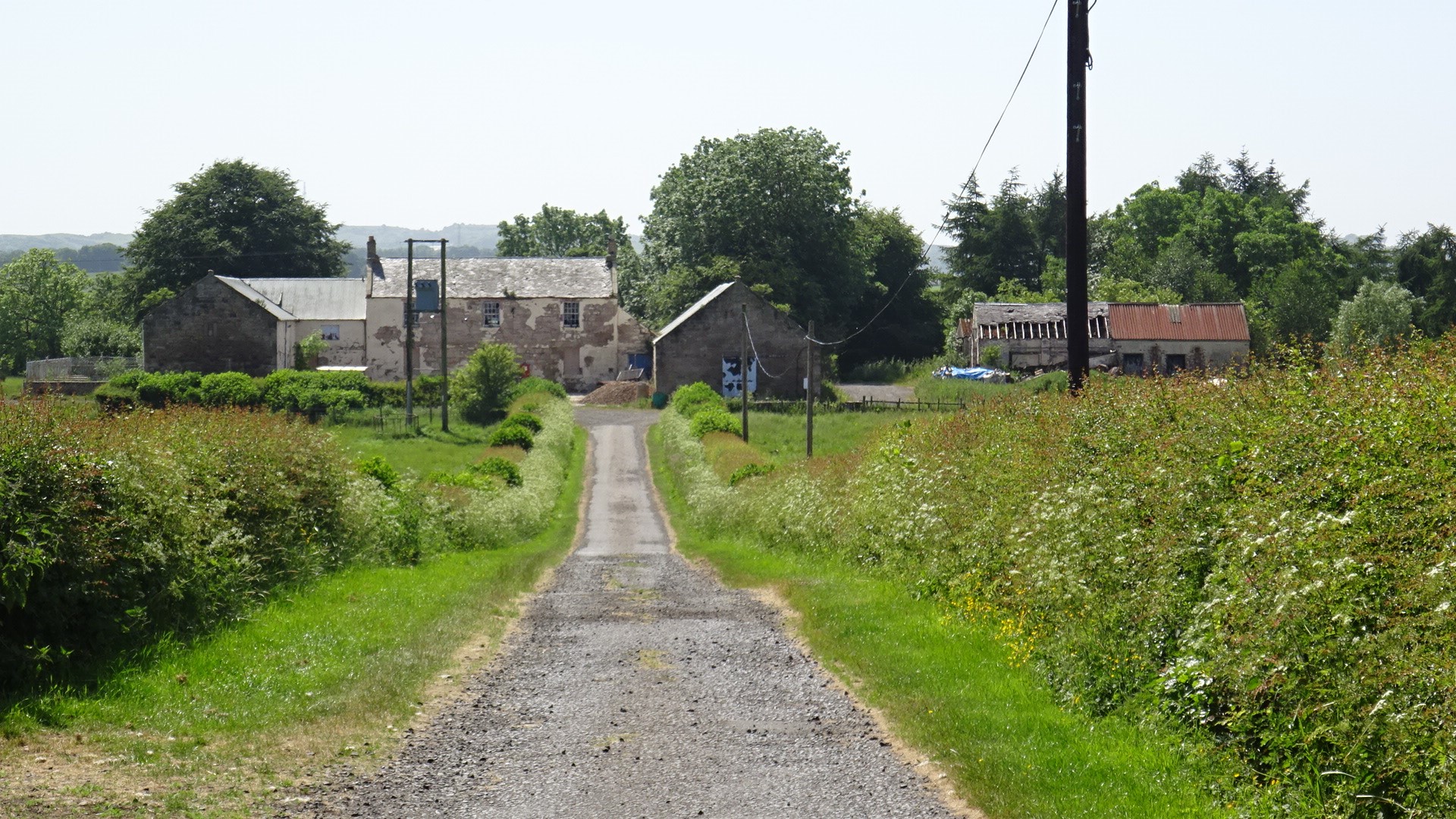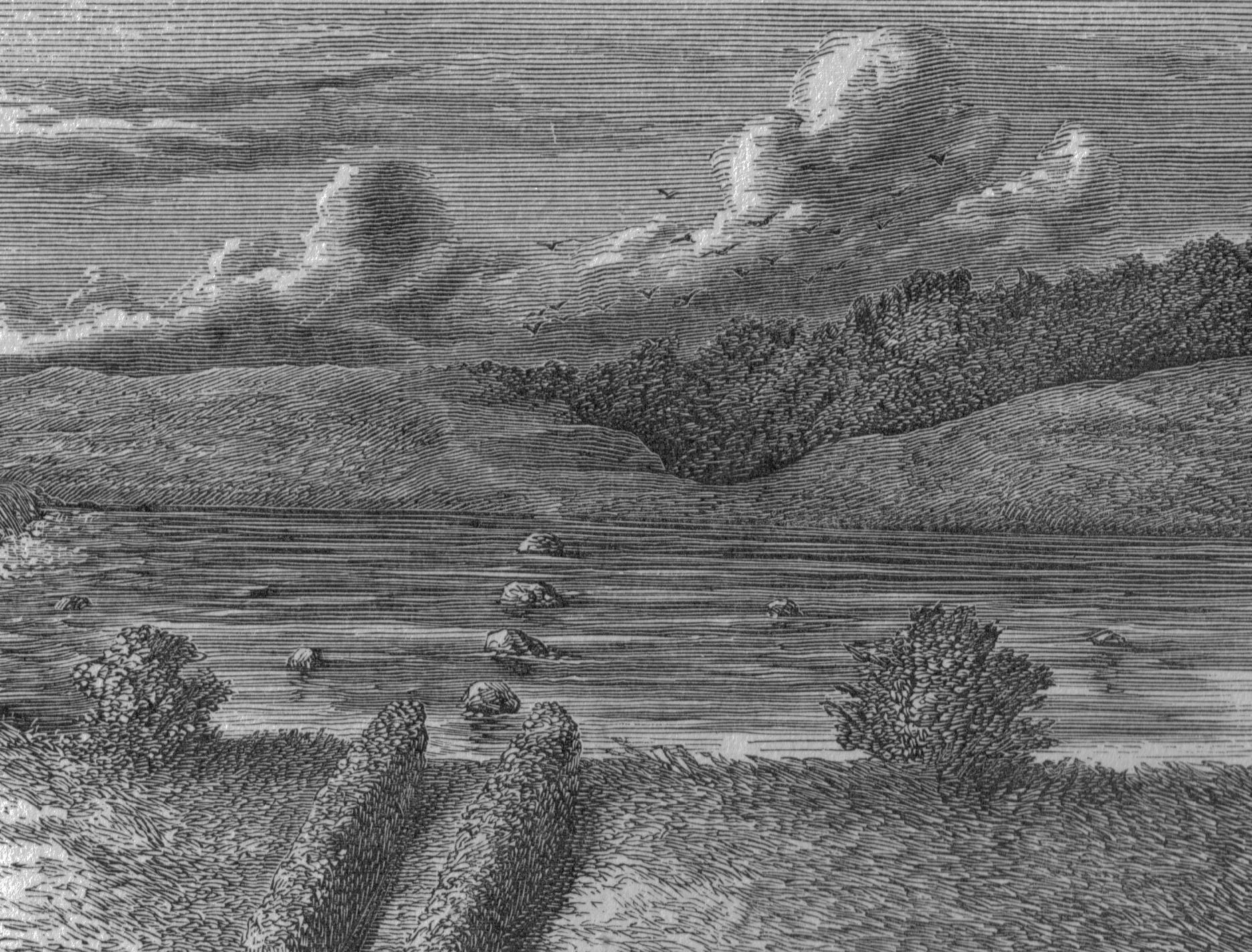|
Blacksyke Tower
The Blacksyke Tower, Blacksyke Engine House, Caprington Colliery Engine House or even Lusk's Folly is a Scheduled Monument associated with a double lime kiln complex in the Parish of Riccarton and is a building of national importance. The Blacksyke site is a significant survival of early coal and lime industries. The engine house's mock Gothic tower house style is very unusual and rare survival of its type. This late-18th-century engine house would be one of the oldest surviving examples of its kind in the United Kingdom. The track bed of the wagonway and several sidings that linked the complex with the Kilmarnock and Troon Railway can still be clearly made out. History In Scots a 'syke' is a small stream, often drying up in summer, that meanders through a hollow or across flat or boggy ground and the 'black' component may suggest peaty ground. A fair description of this low-lying area prone to flooding. The Blacksyke Tower A Newcomen atmospheric pumping engine may have been ... [...More Info...] [...Related Items...] OR: [Wikipedia] [Google] [Baidu] |
Riccarton, Ayrshire
Riccarton is a village and parish in East Ayrshire, Scotland. It lies across the River Irvine from Kilmarnock, this river forming the boundary between Riccarton and Kilmarnock parishes, and also between the historical districts of Kyle, Ayrshire, Kyle and Cunninghame, Cunningham.Adamson, Archibald R. (1875). Rambles Round Kilmarnock. Pub. Kilmarnock. Pps. 49 - 47. The name is a corruption of 'Richard's town', traditionally said to refer to Richard Wallace, the uncle of Sir William Wallace.Wilson, Professor & Chambers, Robert (1840) ''The Land of Burns''. Pub. Blackie & Son. London. P. 74. The parish also contains the village of Hurlford. History The village became a Burgh of Barony in 1638, but its civic powers were never exercised. Riccarton is also sometimes called Ellerslie. In 1875 Riccarton had a population of 1889,Adamson, Archibald R. (1875). Rambles Round Kilmarnock. Pub. T. Stevenson. Kilmarnock. P. 54. but by 1951 that had increased to between 7000 and 8000; many of w ... [...More Info...] [...Related Items...] OR: [Wikipedia] [Google] [Baidu] |
Earlston, East Ayrshire
Earlston is a hamlet in Riccarton, East Ayrshire, Scotland. The habitation dates from at least the early 18th century and is near Caprington Castle and Todrigs Mill. It was for many years the site of a large sawmill and a mine pumping engine, and had sidings of the Glasgow and South-Western Railway's Fairlie Branch. History The present day name suggest a link with an earldom such as that of Dundonald or Glencairn, the latter holding the Barony of Caprington until 1683, however in the mid 18th century the spelling is recorded as 'Earle town' and in Scots this can also refer to a person who is hired "''To engage for service by payment of a sum''" and the expression 'earle-penny' was a "''A coin given as a token of engagement of service.''" Earlston may have been a place where dwellings were provided for Caprington estate workers, many of whom were hired annually at the Dudsday, also Duds' day, or Dud's day hiring fair, a holiday, held at Kilmarnock, originally held at Martinm ... [...More Info...] [...Related Items...] OR: [Wikipedia] [Google] [Baidu] |
Glasgow And South-Western Railway
The Glasgow and South Western Railway (G&SWR) was a railway company in Scotland. It served a triangular area of south-west Scotland between Glasgow, Stranraer and Carlisle. It was formed on 28 October 1850 by the merger of two earlier railways, the Glasgow, Paisley, Kilmarnock and Ayr Railway and the Glasgow, Dumfries and Carlisle Railway. Already established in Ayrshire, it consolidated its position there and extended southwards, eventually reaching Stranraer. Its main business was mineral traffic, especially coal, and passengers, but its more southerly territory was very thinly populated and local traffic, passenger and goods, was limited, while operationally parts of its network were difficult. It later formed an alliance with the English Midland Railway and ran express passenger trains from Glasgow to London with that company, in competition with the Caledonian Railway and its English partner, the London and North Western Railway, who had an easier route. In 1923 the G&SWR f ... [...More Info...] [...Related Items...] OR: [Wikipedia] [Google] [Baidu] |
River Irvine
The River Irvine ( gd, Irbhinn) is a river that flows through southwest Scotland. Its watershed is on the Lanarkshire border of Ayrshire at an altitude of above sea-level, near Loudoun Hill, Drumclog Moss, Drumclog, and SW by W of Strathaven. It flows westward, dividing the old district of Cunninghame from that of Kyle, until it reaches the sea via Irvine Harbour in the form of the Firth of Clyde, and flows into Irvine Bay by the town of Irvine, North Ayrshire, Irvine. It has many tributaries, some of which form parish, district and other boundaries. Etymology ''Irvine'' was first recorded in 1258 as ''Yrewyn'', and several etymologies have been proposed. According to Groome,*McNaught, Duncan (1912). ''Kilmaurs Parish and Burgh''. Pub. A.Gardner. ''Irvine'' is derived from the Gaelic ''iar-an'' meaning 'westward-flowing' river. A Common Brittonic, Brittonic origin is also possible. The root ''*arb-īno'', meaning "wild turnip" has been suggested (c.f. Welsh language, Welsh ''er ... [...More Info...] [...Related Items...] OR: [Wikipedia] [Google] [Baidu] |
Calcium Hydroxide
Calcium hydroxide (traditionally called slaked lime) is an inorganic compound with the chemical formula Ca( OH)2. It is a colorless crystal or white powder and is produced when quicklime (calcium oxide) is mixed or slaked with water. It has many names including hydrated lime, caustic lime, builders' lime, slaked lime, cal, and pickling lime. Calcium hydroxide is used in many applications, including food preparation, where it has been identified as E number E526. Limewater, also called milk of lime, is the common name for a saturated solution of calcium hydroxide. Properties Calcium hydroxide is poorly soluble in water, with a retrograde solubility increasing from 0.66 g/L at 100 °C to 1.89 g/L at 0 °C. With a solubility product ''K''sp of 5.02 at 25 °C, its dissociation in water is large enough that its solutions are basic according to the following dissolution reaction: : Ca(OH)2 → Ca2+ + 2 OH− At ambient temperature, calcium hydroxide (portlandite) ... [...More Info...] [...Related Items...] OR: [Wikipedia] [Google] [Baidu] |
Calcium Oxide
Calcium oxide (CaO), commonly known as quicklime or burnt lime, is a widely used chemical compound. It is a white, Caustic (substance), caustic, alkaline, crystalline solid at room temperature. The broadly used term "''lime (material), lime''" connotes calcium-containing inorganic materials, in which carbonates, oxides and hydroxides of calcium, silicon, magnesium, aluminium, and iron predominate. By contrast, ''quicklime'' specifically applies to the single chemical compound calcium oxide. Calcium oxide that survives processing without reacting in building products such as cement is called free lime. Quicklime is relatively inexpensive. Both it and a chemical derivative (calcium hydroxide, of which quicklime is the base anhydride) are important commodity chemicals. Preparation Calcium oxide is usually made by the thermal decomposition of materials, such as limestone or seashells, that contain calcium carbonate (CaCO3; mineral calcite) in a lime kiln. This is accomplished by hea ... [...More Info...] [...Related Items...] OR: [Wikipedia] [Google] [Baidu] |
Ordnance Survey
, nativename_a = , nativename_r = , logo = Ordnance Survey 2015 Logo.svg , logo_width = 240px , logo_caption = , seal = , seal_width = , seal_caption = , picture = , picture_width = , picture_caption = , formed = , preceding1 = , dissolved = , superseding = , jurisdiction = Great BritainThe Ordnance Survey deals only with maps of Great Britain, and, to an extent, the Isle of Man, but not Northern Ireland, which has its own, separate government agency, the Ordnance Survey of Northern Ireland. , headquarters = Southampton, England, UK , region_code = GB , coordinates = , employees = 1,244 , budget = , minister1_name = , minister1_pfo = , chief1_name = Steve Blair , chief1_position = CEO , agency_type = , parent_agency = , child1_agency = , keydocument1 = , website = , footnotes = , map = , map_width = , map_caption = Ordnance Survey (OS) is the national mapping agency for Great Britain. The agency's name indicates its original military purpose (se ... [...More Info...] [...Related Items...] OR: [Wikipedia] [Google] [Baidu] |
Lime Kiln
A lime kiln is a kiln used for the calcination of limestone (calcium carbonate) to produce the form of lime (material), lime called quicklime (calcium oxide). The chemical equation for this chemical reaction, reaction is :Calcium carbonate, CaCO3 + heat → Calcium oxide, CaO + Carbon dioxide, CO2 This reaction can take place at anywhere above 840 °C (1544 °F), but is generally considered to occur at 900 °C(1655 °F) (at which temperature the partial pressure of CO2 is 1 atmosphere (unit), atmosphere), but a temperature around 1000 °C (1832 °F) (at which temperature the partial pressure of CO2 is 3.8 atmospheres) is usually used to make the reaction proceed quickly.Parkes, G.D. and Mellor, J.W. (1939). ''Mellor's Modern Inorganic Chemistry'' London: Longmans, Green and Co. Excessive temperature is avoided because it produces unreactive, "dead-burned" lime. Slaked lime (calcium hydroxide) can be formed by mixing quicklime with water. Early li ... [...More Info...] [...Related Items...] OR: [Wikipedia] [Google] [Baidu] |
Glenfield (company)
Glenfield is a large industrial manufacturing company based in Kilmarnock, Ayrshire, Scotland. At its height it was reckoned to be the largest company of its type in the Commonwealth. Company history Thomas Kennedy (senior) was a watch and clockmaker, who moved to Kilmarnock in 1824 from Argyleshire. At around that time, he patented the Kennedy Water Meter, which he designed with the help of John Cameron, another watchmaker in Kilmarnock. A valve directs water entering the meter into a cylinder of known volume containing a piston. As the piston rises and falls, the measured quantity of water is expelled and the mechanism is connected to recording dials to track the volume of water used. In 1863, the Kennedy Patent Water Meter Co Ltd was established on a site formerly used by the Glenfield Printing Works. Two years later, Kennedy established Glenfield Co Ltd on the same site, which specialised in the supply of castings and general foundry work. Kennedy's nephew, also called Thomas K ... [...More Info...] [...Related Items...] OR: [Wikipedia] [Google] [Baidu] |







